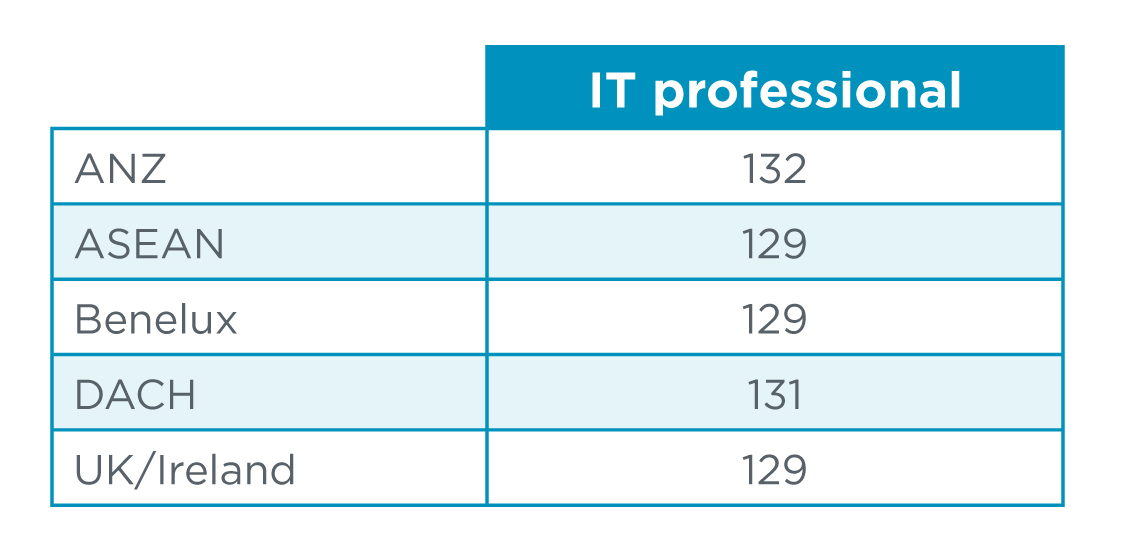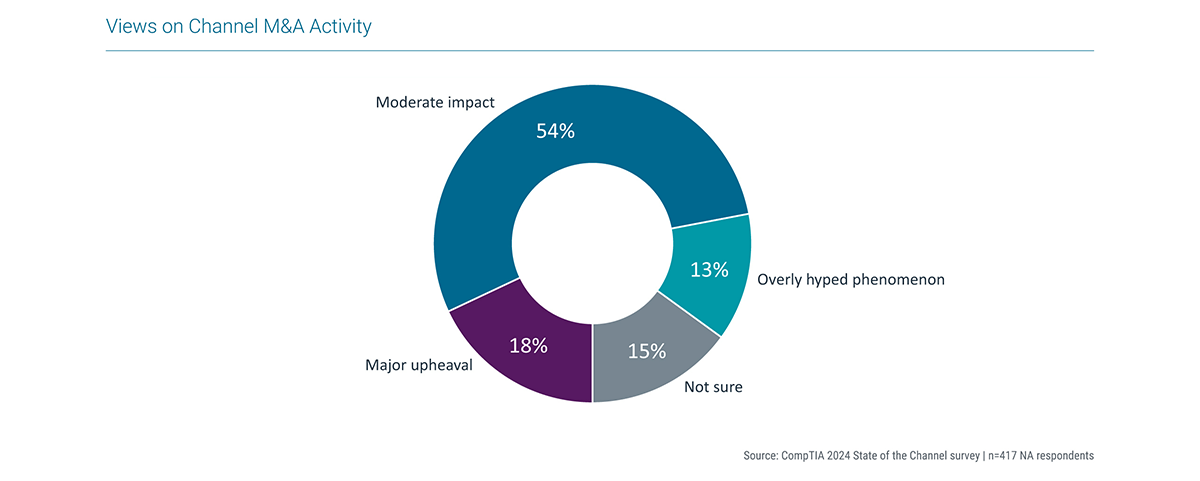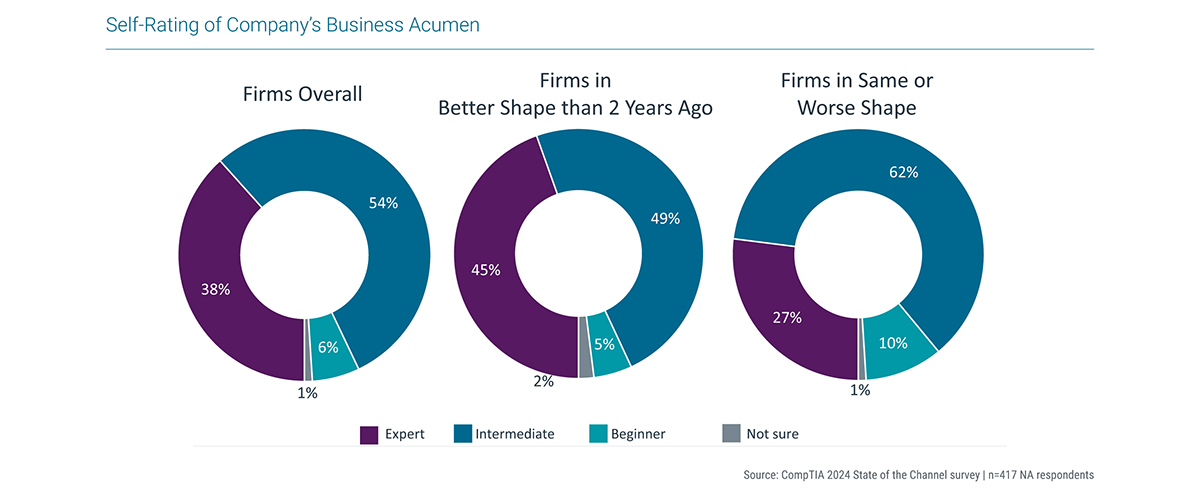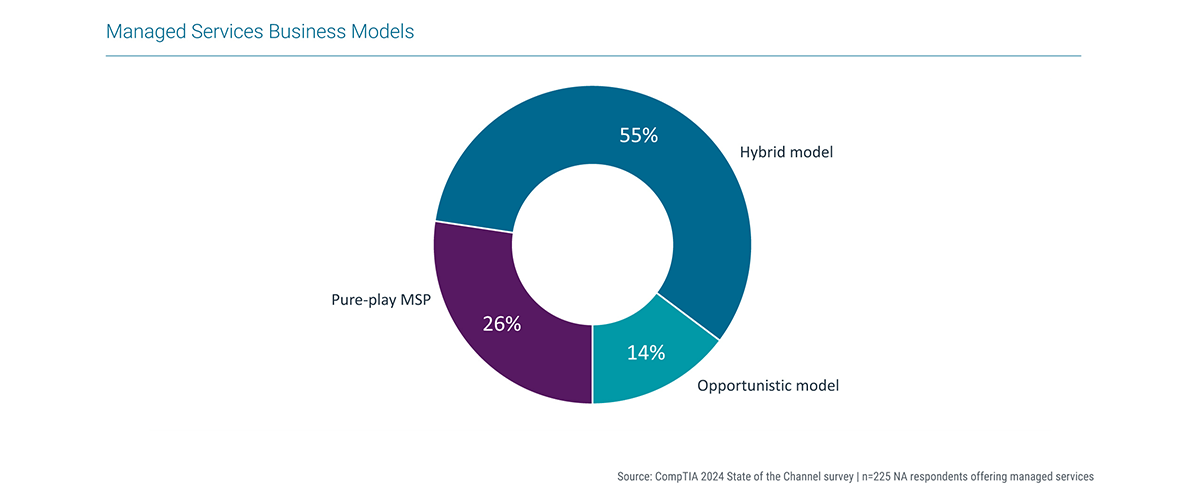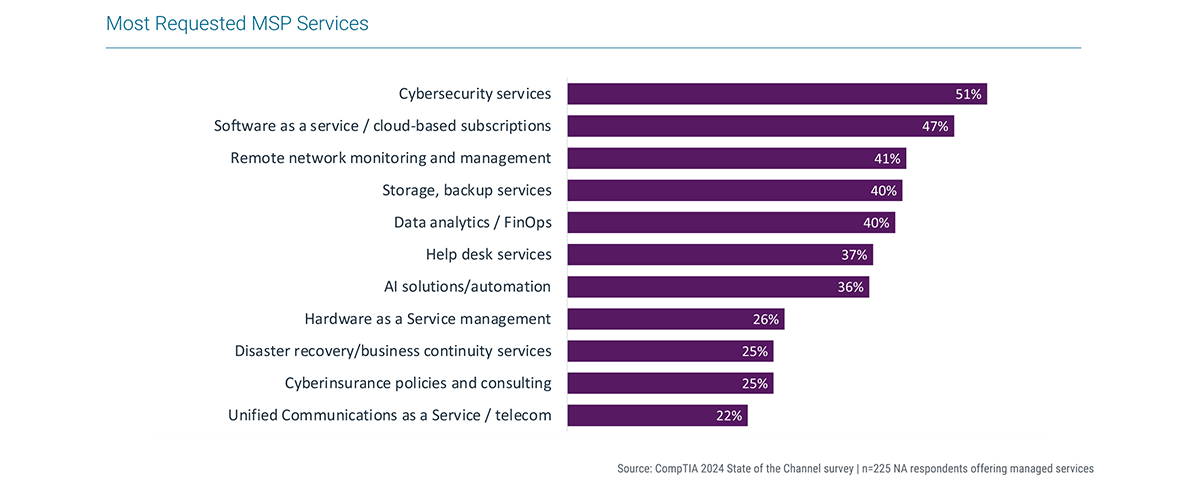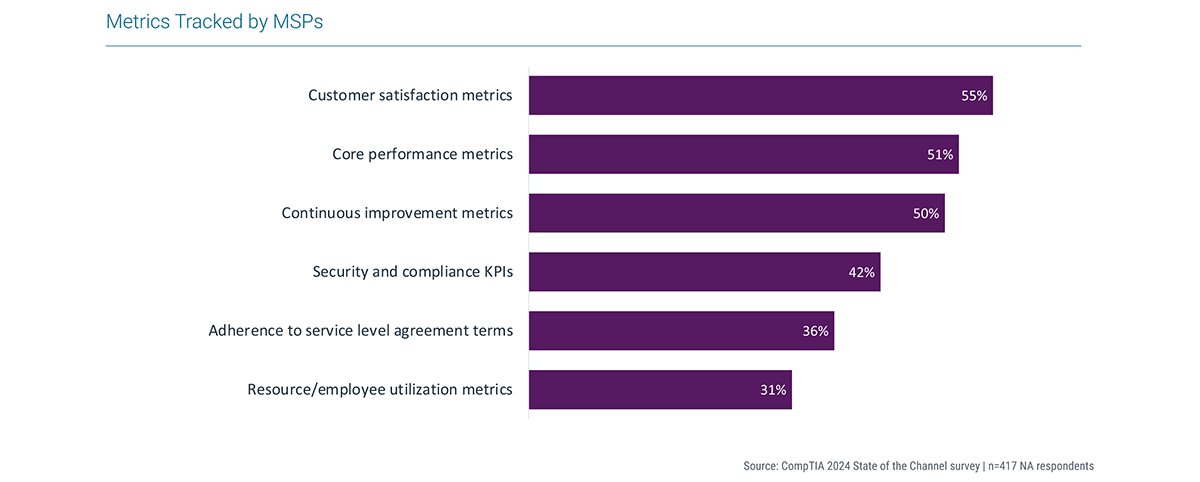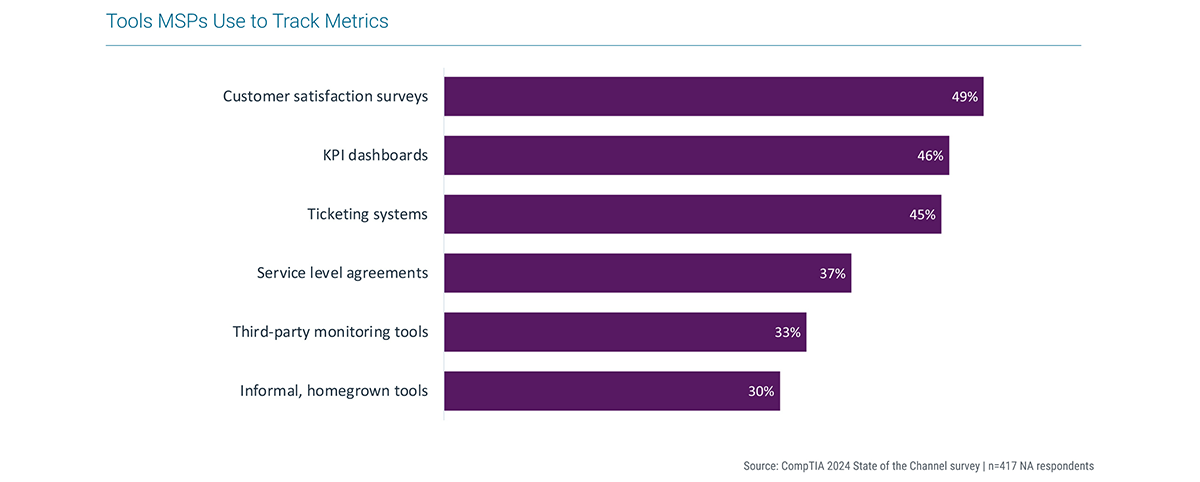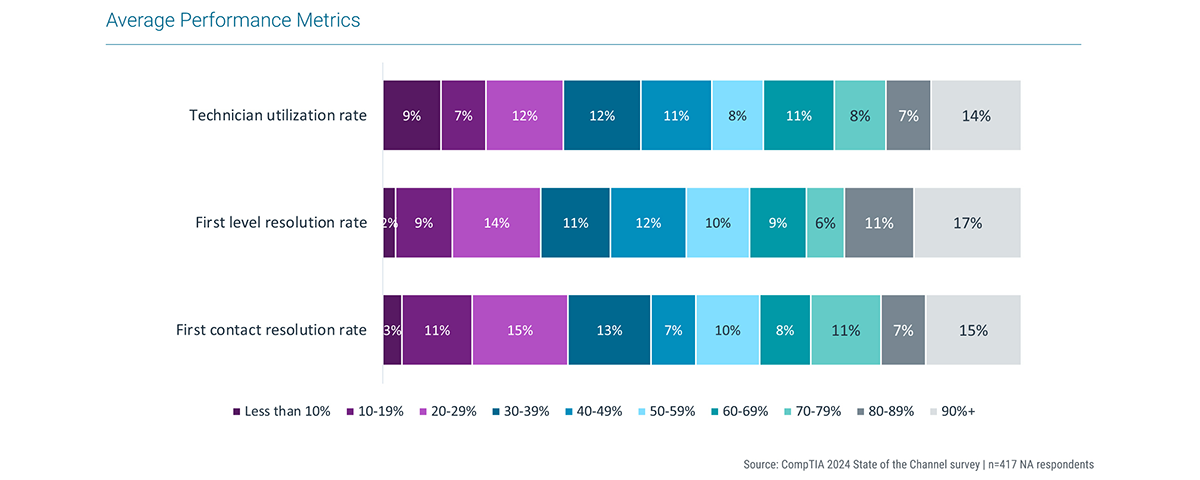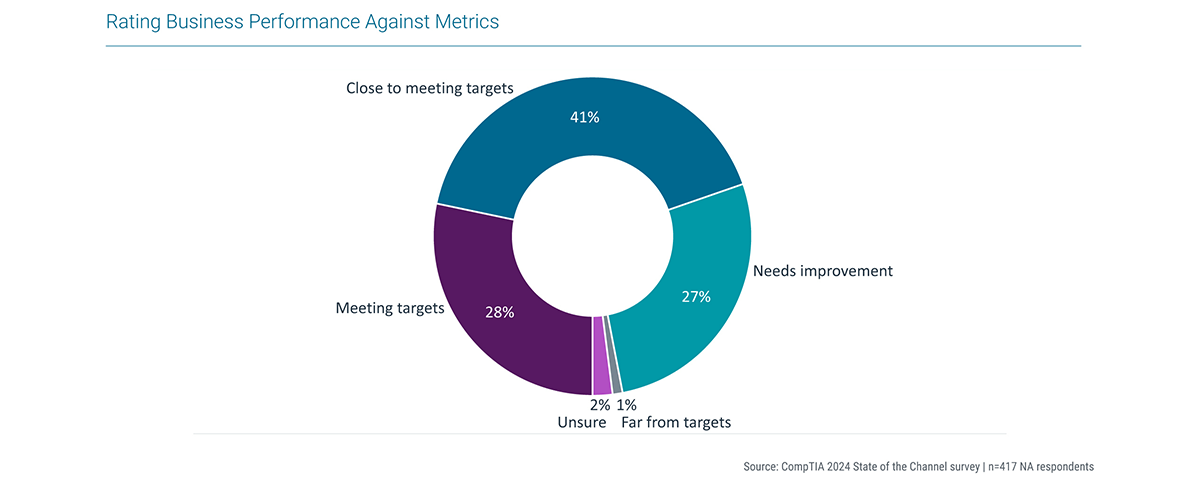V iewed in the context of the broader technology industry, the IT channel comes across as a venerable, largely stable part of the greater ecosystem, with companies reporting that they continue to successfully sell and recommend technology products and services while also facing industry and business challenges both old and new.
But that’s just one piece of the story.
As many of those in the trenches know, the IT channel is filled with flux and nuance, some clever innovations and glaring weak spots. While many companies are content to report more of the same from their business operations as last year, other cohorts hail risk-taking and deft changes in direction. Some of those charting new paths are experiencing notable growth, while others trying new things or doubling down on the old are nonetheless struggling. Others in the ecosystem don’t identify as channel firms at all. Perhaps the one consistent theme seems to be that there isn’t one.
And while this might be the first legitimately post-pandemic year in terms of more normalized business planning for the channel, much uncertainty remains about the direction of the economy, the political landscape worldwide, and the explosion of new developments and trends happening on the technology and business fronts. The impact will be felt by channel firms, their vendor partners, and crucially, the customers they both serve. Likewise, the upsides and downsides of generative artificial intelligence (AI) and automation, cybersecurity threats, the dramatic changes in customer buying habits and the taste for technology generally are all factors in play.
There’s a lot going on in other words. The CompTIA State of the Channel 2024 report looks to examine portions of that activity with the goal of helping current and aspiring firms better understand their market to compete and grow their business. The research explores many of the dynamics in play for today’s channel, including data on the ecosystem’s relevance and composition; challenges and opportunities; business assessments and metrics; vendor relationships and the competitive landscape.
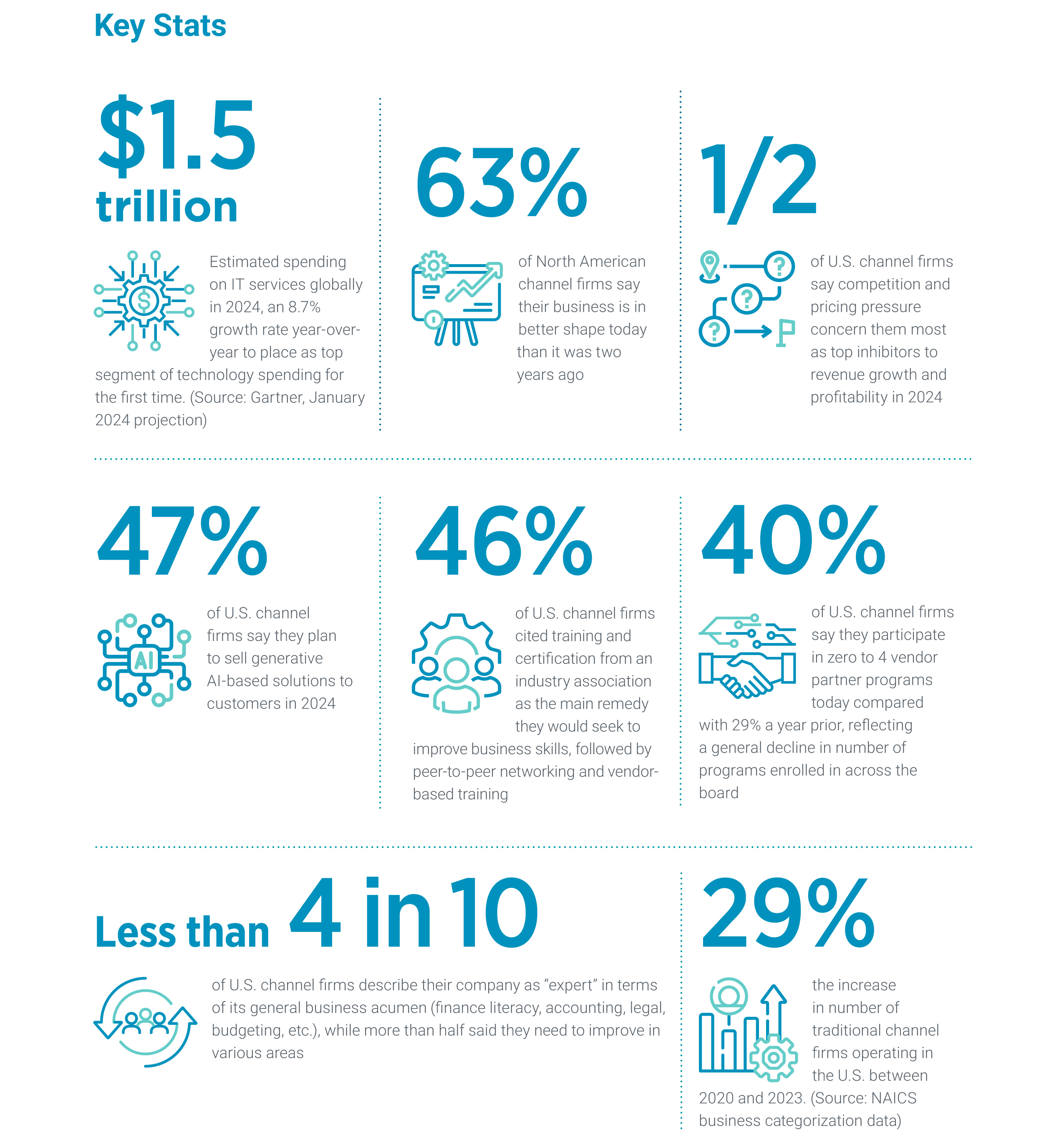
Market Overview
With most experts and government pundits in agreement at the outset of 2024 that it’s looking like a soft landing and not a recession for the economy, channel firms arguably have more breathing room to think about growth, investment and innovation than they have in the previous two years. Gartner is forecasting worldwide spending to grow by 6.8% in 2024 over 2023. Notably, the forecast calls for an 8.7% jump in spending in IT services (to $1.5T worldwide), catapulting that category to the top of the various tech groupings for the first time, eclipsing even software.
Gartner attributes the IT services gains primarily to enterprise investments in efficiency and optimization projects that necessarily went into high gear during the pandemic-induced period of economic shakiness. The benefits aren’t confined to the big-name global services firms and integrators that serve enterprise corporations, however. The downstream impact of this kind of demand affects the broader channel, including managed services providers (MSPs), IT consultants, solution providers and others, that garner a large chunk of revenue from this type of work – or those that wisely seek to do so in 2024 and beyond. Similarly, IDC is forecasting spending on digital transformation projects, which also encompass a wide range of tech services familiar to the channel, to reach nearly $3.9T by 2027, a compound annual growth rate (CAGR) of 16.1% from 2023.
With market conditions seemingly calming but always subject to change, how will the channel approach 2024? The short answer is a mix of old and new tricks, most likely. While the pandemic has left an indelible mark on the business psyche and permanently changed the contours of where and how we conduct work, COVID isn’t likely to be specified among the decision-making vectors for tech executives this year. Instead, channel practitioners will fill their to-do list with items ranging from how to embrace new technologies like AI; handle new types of competition and market changes; capitalize on new and more sophisticated services opportunities; optimize and improve internal business functions and better serve customers and the workforce.
“The IT channel faces challenges with cybersecurity risks, a shortage of skilled professionals, navigating fast-paced technology changes and ensuring a smooth integration of these changes. Adapting to evolving market demands will be our biggest challenge and area of opportunity for the future of the IT channel.”
— Hannah O’Donnell, vice president of sales at GreatAmerica Financial Services and chair of the CompTIA Community – North America
For purposes of this study, six geographic regions across the globe participated in the research: North America, the United Kingdom and Ireland, Benelux (Belgium, Netherlands, Luxembourg), DACH, ASEAN and ANZ (Australia-New Zealand). A few of the top findings will be detailed here at the outset across all six regions, then the rest of this report will reflect North American data. Individualized report briefs are also available to highlight more of the study results from the other regions included in data collection.
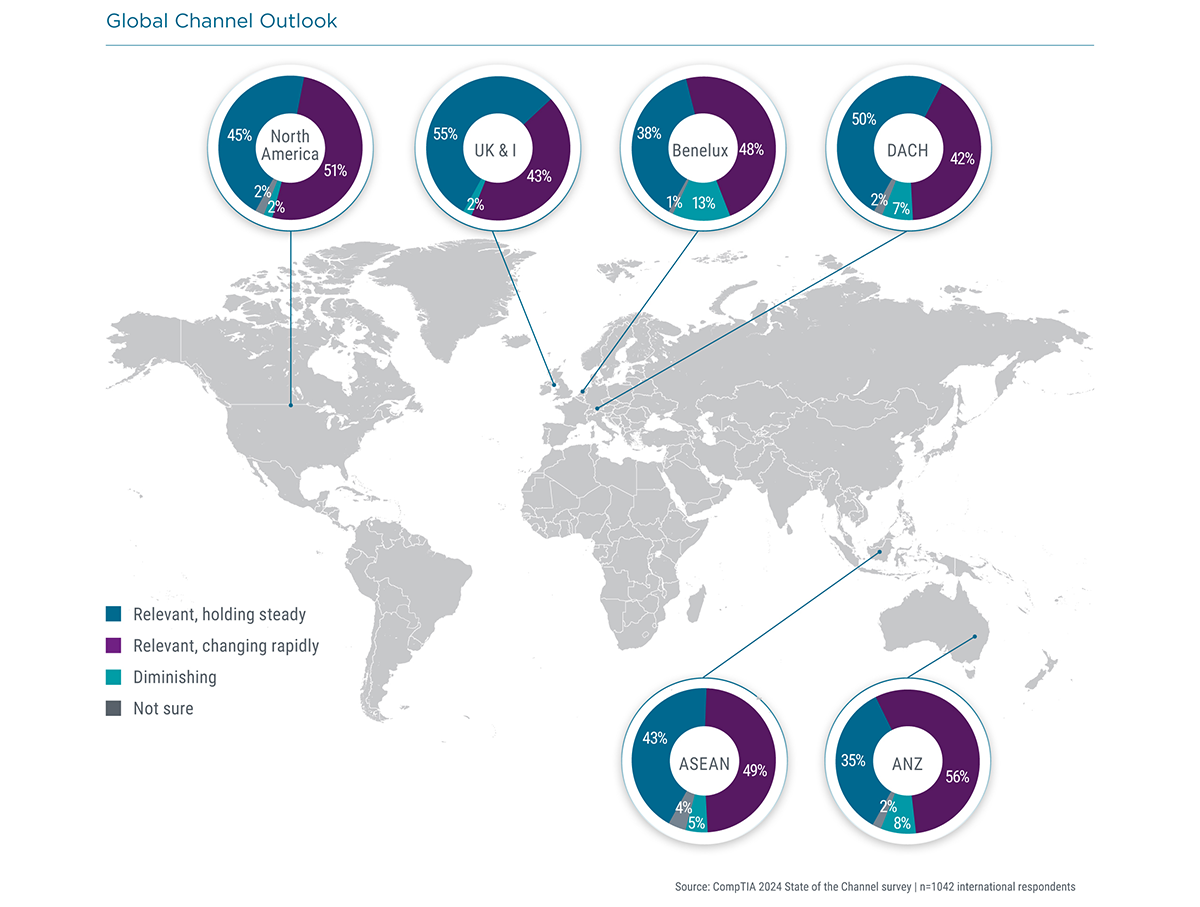
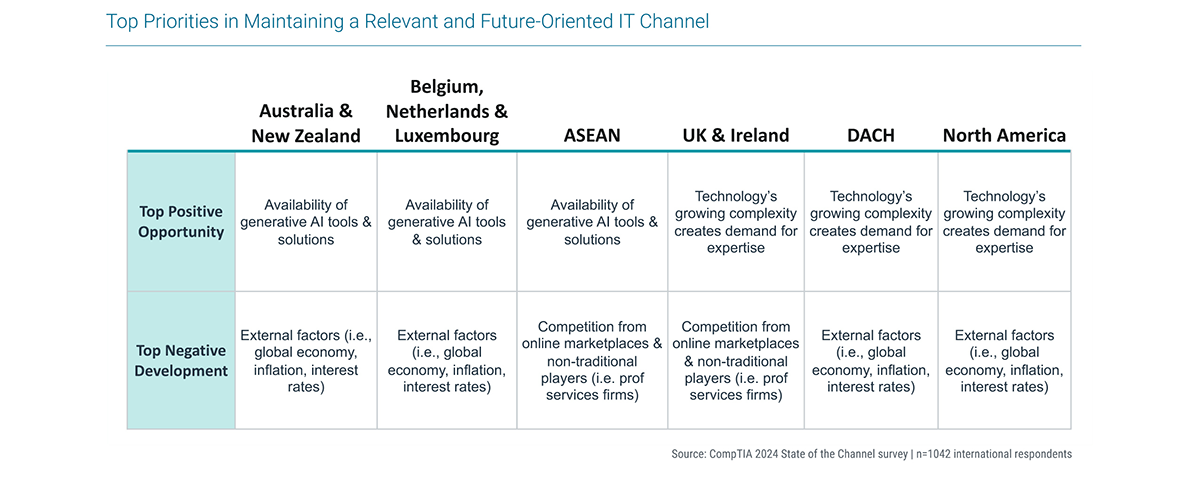
There is some unanimity among regions for what factors could potentially drive the channel in a positive or negative direction in 2024. On the positive side, half of the six regions (see accompanying chart) cite the increasing complexity of technology as the top opportunity for the channel. Why? Because it will drive market demand for tech expertise, they contend. The other half of the regions are banking on the availability of generative AI tools and solutions to sell as the top driver for the year ahead. This remains a big “if” with respect to the channel. At this juncture, the jury remains out on whether AI’s path this year will result in a raft of commercial products to sell or if the tools are more likely to land as an enabling technology built into services and solutions. That said, if greater technical complexity generally does indeed stir up demand for channel expertise, it will be further propelled if customers seek help with AI strategies.
In terms of negative factors, the potential headwinds for the channel this year are also mostly shared among regions, according to the research. Four out of six cite external events as the No. 1 factor that could knock their businesses off course. These events, largely out of the control of individual businesses, would include the direction of the global economy, inflation and interest rates, among other potential developments. The top concern for the other two regions in the study is formidable competition from behemoth online marketplaces as well as from non-traditional firms that sell technology products and/or services. The increasingly complicated competitive landscape will be discussed in more detail below.
On a positive note, most channel firms report that their businesses are in better shape today than two years ago. On average, around 6 in 10 respondents said things are generally better today, compared with around 3 in 10 that said business is the same as two years ago, and just 1 in 10 that find their situation worse. Many factors contribute to a company’s performance levels year-over-year, obviously, including general market conditions that two years ago included the pandemic, chosen business model, adaptability to change, willingness to invest and innovate, caliber of workforce and some good, old-fashioned luck.
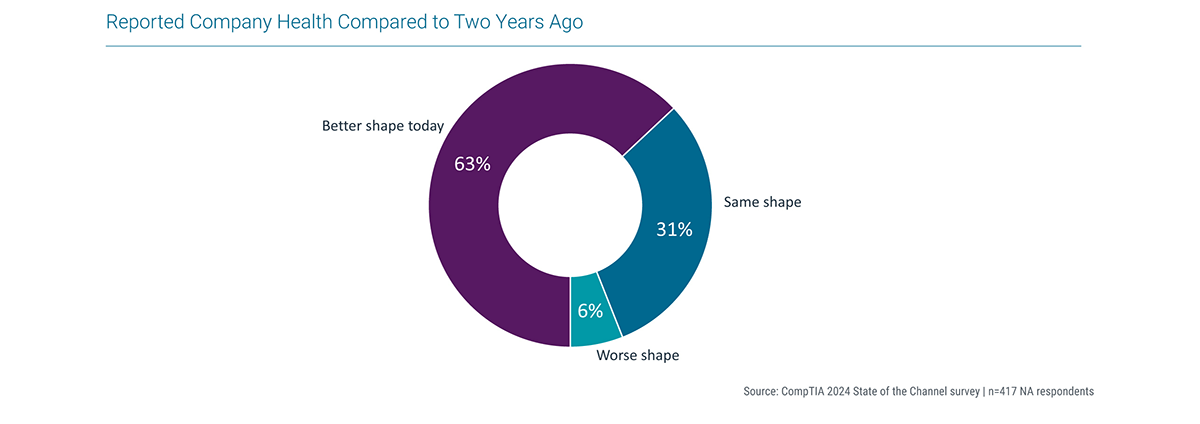
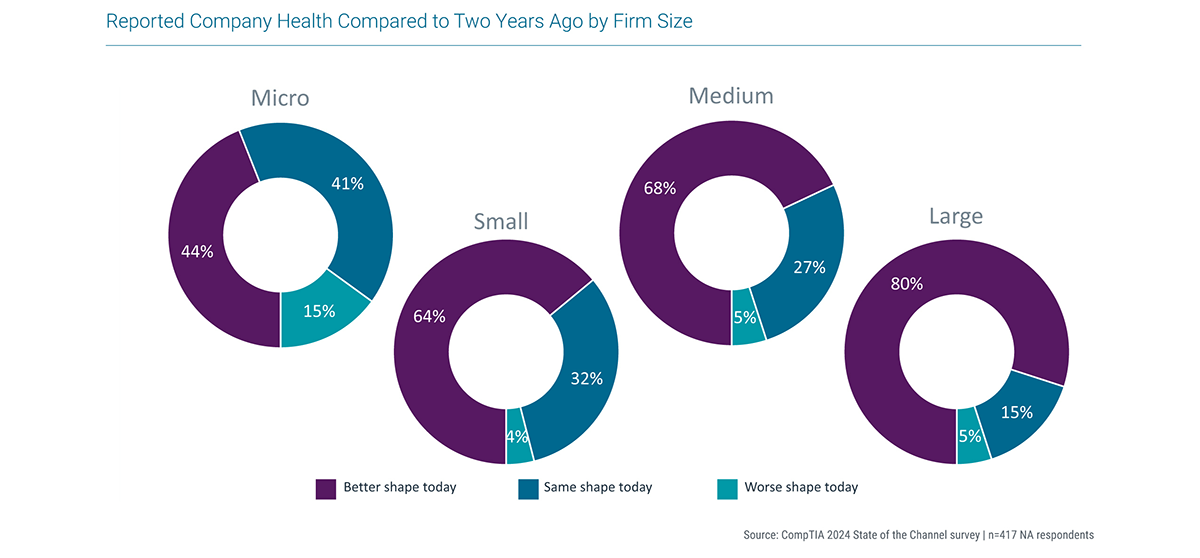
Drivers & Inhibitors for Channel Health
In many ways, the channel ecosystem features two main camps filled with a variety of camper types. On one side sit those firms with a more traditional reseller heritage: Mostly stable, product-oriented SMB businesses with expertise in technology infrastructure work. The other camp includes newer entrants, those focused more closely on cloud-, digital- and services-based business models that aren’t as product-centric. Across these groups, however, you find abundant individual diversity, from referral-based providers to pure consultants to vertical specialists and beyond. And while some of these business types are more ascendant and high growth than others, each is carving out a space in the landscape.
How channel firms identify themselves is instructive to this study in terms of how each group responds to various questions asked. Self-identification also underscores the stratification that exists among the “many campers” of the channel as discussed above.
A decade or more ago, if you’d asked a channel owner or employee to describe their primary business to a lay person, it’s more than likely they’d say that they sell technology or computer products. That makes sense, especially more than 10 years ago when the preponderance of the channel remained VARs and solution providers steeped in hardware sales and implementations, as well as the sale of packaged software and licenses. Yet today, the percentage that say their primary business is products is 27%, eclipsed by those that self-identify mainly as purveyors of services.
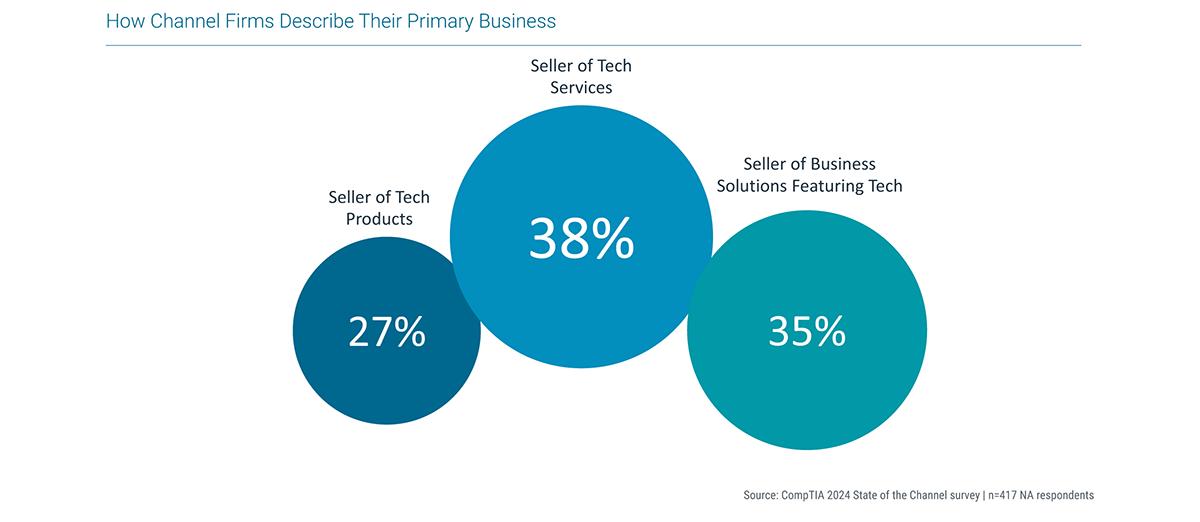
The attention to services can be seen as welcome news, especially given that IT services for the first time represents the biggest spending category for the global IT market, according to Gartner. In other words, this is where the money is flowing. Services margins tend to be higher than product sales – though not in all cases – and stickier in terms of becoming recurring revenue engagements. This category features subsets of work including IT outsourcing, professional services and managed services. Activity here is often driven by developments in the marketplace such as new technologies like AI or project initiatives like digital transformation and cloud migration. As more customers conduct direct transactions for goods over online marketplaces and/or vendor e-commerce storefronts, the real play for many channel companies is going to be the services they can sell and provide in and around that initial sale.
What’s particularly interesting is the 35% of respondents that identify as sellers of business solutions that feature technology. The prioritization of business acumen and consulting here is key. This has been the direction many of the most successful channel firms have been going in the past several years: towards being an expert with deep knowledge of their customer’s business and goals who then applies technology to drive the mission.
Now, looking beyond individual businesses to the big picture, consider what respondents have to say about the state of the channel’s health today. In the aggregate, half (51%) said today’s channel remains relevant but is also changing rapidly. Whether that change is welcome or not, this group nonetheless notes that it is happening to everything from go-to-market sales and delivery trends, pricing and competition, business model status, customer preferences and habits, and other measures. Another 45% of the total say the channel remains relevant but steady as she goes rather than changing rapidly. This perceived steadiness likely reflects respondents seeing little fluctuation in their business in terms of its everyday operations, expectations and performance. Just 2% of respondents believe channel relevance is diminishing.
Interestingly, the share of firms in this year’s study that believe the channel is changing rapidly (half) has returned to about the same level reported in 2021 when the pandemic was in full tilt and companies were making all kinds of adjustments and pivots to survive the unprecedented economic conditions. Between those two time periods, in last year’s study, the percentage reporting rapid change in the channel had declined to 43% of respondents, perhaps reflecting the situation at the tail end of the pandemic when companies weren’t making grand changes, but simply shaking themselves off and assessing how well – or not – they’d withstood the massive upset in business normalcy. But now, as we enter 2024, with the hype around generative AI and glimmers of a resurgent economy, channel firms sense a return to action – and possibly more opportunity.

What will contribute to a healthy trajectory for the channel in the years ahead? As stated above, when looking across all six regions in the study, it’s clear that the impact that increasing complexity of technology will have on driving demand for experts and the emergence of AI tools and solutions are considered catalysts to success. Likewise, the regions agree that negative external factors could spoil the party, as could steep competition from non-traditional sources.
When looking at the United States data specifically, the list goes further than just those top items. In keeping with a theme that is expected to continue unabated for the foreseeable future, 52% of respondents cited increasing demand for cybersecurity services as a driver for positive momentum. As general tech complexity mounts, the need for sophisticated, encompassing cybersecurity strategies will also rise, and the channel is in a perfect position to act as expert lead to help customers carry those out. This, of course, will require attention to cybersecurity as a highly skilled discipline with firms versed in everything from zero trust architectures to cyber insurance and beyond. The days of table stakes product selling of antivirus and firewall packages is unlikely to be enough for firms that really want to drive revenue from cybersecurity pursuits.
“One of the biggest challenges we continue to see year after year is finding and retaining IT and security talent to handle anything from Level 1 support to advanced threat hunting, and that will continue to be a challenge in 2024.”
—Scott Barlow, VP global MSP & cloud alliances, Sophos, and vice chair, CompTIA board of directors
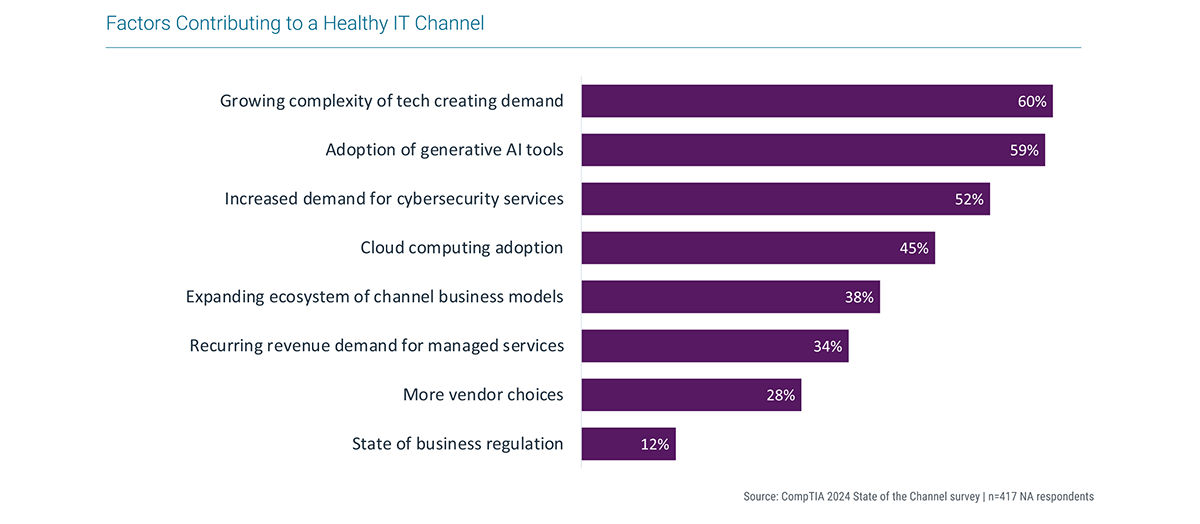

As far as the negatives go, the items causing worry are more balanced in terms of ranking among respondents once you get past their No. 1 concern about external macroeconomic factors. Just less than a third of respondents list five items equally (see accompanying chart) as having potential to derail a positive direction for the channel in the year ahead. One to note is the concern over weak profit margins for subscription sales. The SaaS market, which has exploded in the last decade, is both an opportunity and a frustration for the channel, depending in part on how vendors construct compensation programs for their partners that sell subscriptions. The percentages paid out on initial contract sale, renewals and ongoing residuals can vary widely by vendor and partner type. The lack of standardization has sparked consternation in some parts of the channel community. Whether that is resolved in the year ahead remains to be seen.
There are other areas where attitudes about the channel’s health vary across respondent types. For example, 41% of product-centric businesses reported the channel as changing rapidly, compared with 55% and 54% of firms, respectively, that either mainly sell tech services or business solutions that include technology. By way of explanation, the services-oriented channel firms are the ones most likely to have undergone a business model transition away from products as their core business (perhaps reseller to MSP), and as a result experienced significant change in what they do, how they sell, who they hire and how they run their companies.

Mergers & Acquisitions Update
Every year sees thousands of mergers and acquisitions (M&A) in the IT channel. This has led some industry watchers and tech vendors to wonder whether the level of dealmaking would lead to consolidation within the IT channel. Most market data suggest significant consolidation has not occurred thanks, in part, to the number of new entrants that have entered the market in recent years. (see Channel Sizing chart in this report). That said, there are reasons to believe that M&A activity will remain at a high level, if not increase, as interest rates come down, making it easier for companies to borrow money to merge with or acquire another company.
Consider findings from this year’s study. Asked the likelihood of their company entering a deal to sell to another company in the next two-to-five years, nearly half (46%) of respondents indicated this would be a highly or somewhat likely occurrence. As for buying another company, the number is even higher. Fifty-five percent of respondents said their company would likely move to acquire another company.
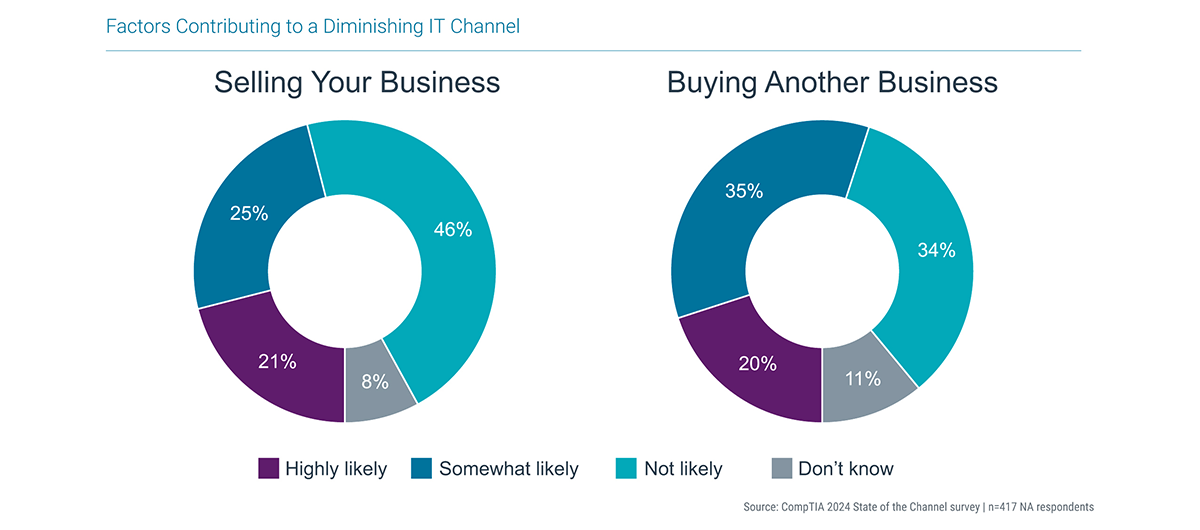
In general, larger organizations with greater access to capital are more likely to engage in dealmaking activity. This is evidenced by well-funded companies such as The 20, which acquired 13 MSPs in 2023 as part of its ongoing mission to build a true national IT service provider, and Upstack, which has raised hundreds of millions of dollars from private equity companies since 2021, to acquire telecom advisory organizations.
In addition to the money pouring into the IT channel that is used for M&As, there is another reason why dealmaking has been at such a high level in recent years: Changing demographics.
Thousands of channel companies have changed ownership in the last decade as Baby Boomers retire and sell their businesses to the highest bidder. Newcomers not only bring new financing to the channel, but they also usher in a new era of professional management thanks to their increased use of technology automation platforms. Platforms such as PSA tools have made it easier for channel companies standardize their operations and embrace best practices. This, in turn, has given would-be buyers greater confidence that they can successfully integrate acquired companies into their organizations.
Business Lines, Profit & Revenue
Returning to the many types of campers’ metaphor, this section dives deeper into the myriad activities that channel firms conduct as part of their business and where they see revenue and profitability both growing and, in some cases, declining.
As has been the case for years, the most cited business line respondents say they offer is that of a solution provider, which covers a lot of technology work from product selling and implementation to integration, bundling and other tasks. Two thirds of channel firms in the study identify solution providing as a primary business line, ahead of the next two most prevalent portfolio items, consulting (52%) and data services (50%). This represents a big increase from the 50% that checked off the solution provider category among its business lines offered in last year’s study. This could be explained by companies today including more types of work under the general umbrella of solution provider. Consulting or cybersecurity services would be a couple examples of areas that previously might have been considered standalone categories not to be lumped in with more traditional solution provider infrastructure activity. Today, while both disciplines are still considered a specialty, they are indeed often packaged together with more holistic sets of offerings – and should be, especially in the case of cybersecurity.
This speaks to the reality that most channel firms today are hybrid in terms of their product category offerings and the types of services they provide to customers. By hybrid, however, it usually means that they bank on one or two primary sources of revenue as their main business strength but have adjacent skills that comprise smaller pieces of their portfolio. That’s likely why, for example, 45% of respondents today say they offer application development services (a discipline not historically known as a channel mainstay). App dev might comprise a tiny sliver of a firms’ total revenue but because the company does some coding work as part of other projects, it appears on their line card as a business offering. An example? Something like integration often involves coding to tie applications together from cloud to on-premises, a type of work channel firms routinely conduct.
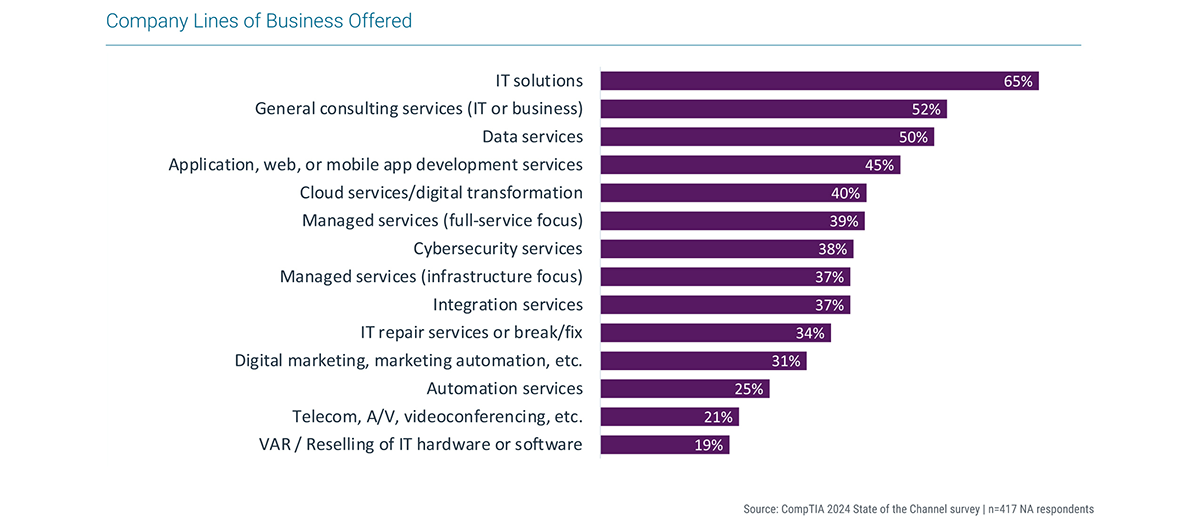
There are a few things to note in the segmentation data about business lines. One, companies that say they are in better shape today than two years ago singled out offering cybersecurity services (separately from any solution provider activity) by a wide margin over companies that reported being in the same or worse shape. Forty-four percent of the former group vs. 26% of the latter count cybersecurity services as a main business line, which may very well have much to do with their purported success in the last two years. Before generative AI devoured much of the tech industry hype in 2023, cybersecurity was the main stage player, and it still is in terms of its importance/need among customers and its revenue-driving ability for the channel. Case in point? Like last year’s research, cybersecurity remains the service that MSPs in today’s study (half of them) say is most in demand by their customers.
Another notable from the segmentation on business lines is that younger channel firms are full-on embracing consulting services. More than two thirds (67%) of companies in business two- to four years feature general IT and business consulting as the No. 1 service that they offer, reflecting that shift from product-centric to services-based business models. That compares with roughly half of channel firms in older age brackets in terms of years in business.
When it comes to revenue expectations for the next two years, cybersecurity is leading the way in terms of the most superlative growth, at least among those offering it to customers today. Forty-one percent of channel firms said they expect a significant increase in cybersecurity-related sales in the next two years (78% expect an increase in general). Other areas in ascendance? Managed services (infrastructure and full service), application development and automation services, which would be generative AI solutions that will be discussed shortly in this report. Of the categories where the biggest revenue declines are anticipated, respondents cite VAR/reselling and telecom.

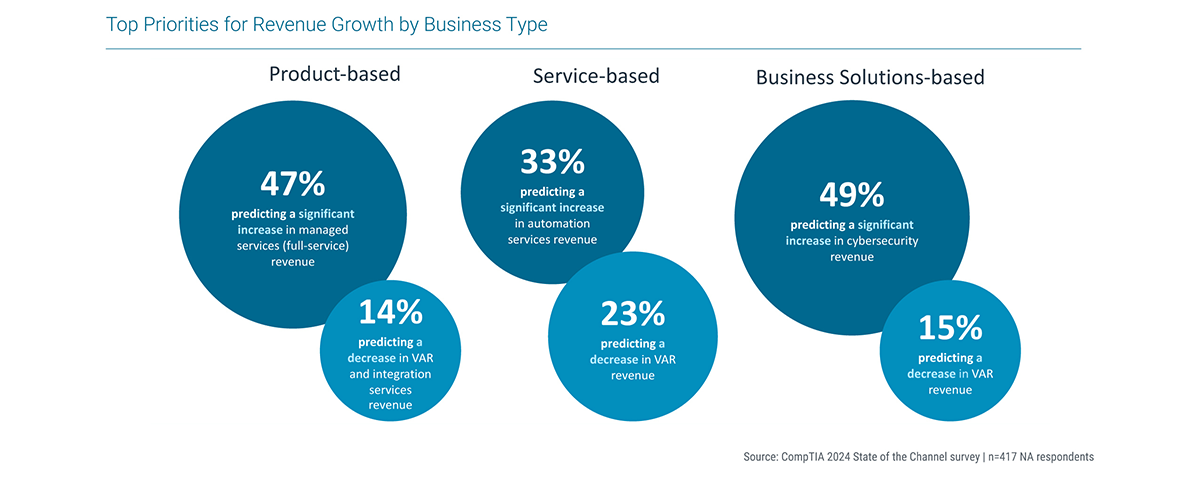
As far as profitability goes, most of the expected high revenue drivers are also pegged as the biggest moneymakers, though the list across all categories is more balanced than one might expect. Cybersecurity and automation services are signaled to reap significant profits, but not at much greater percentage expectation than telecom, for example. This seeming inconsistency highlights the fact that a mature tech category, such as telecom, might not generate the most in terms of revenue yet will still produce lucrative profit margins on the products and services that are sold.
Predictions are always subject to caveat, and those made about revenue and profitability are no exception. Respondents highlighted several inhibitors that could tap the brakes on their optimistic projections for the coming two years. Leading the list are three factors, all somewhat related. The first, cited by 49% of respondents, is competition and pricing pressure. The competitive landscape has expanded greatly as the channel ecosystem and customer buying habits have changed in the last decade.
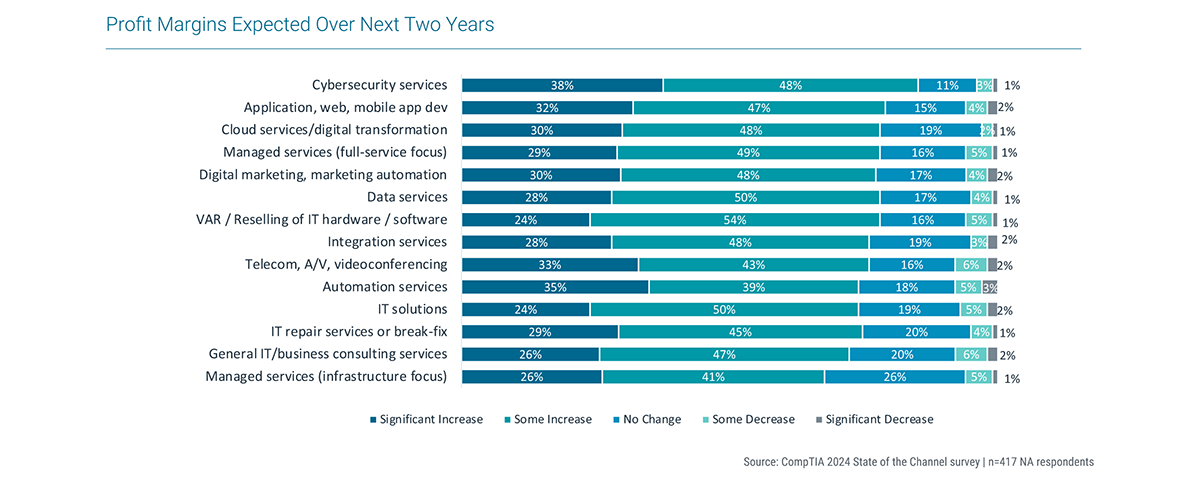
The ubiquity and might of the major online marketplaces such as Google’s, Amazon’s and Microsoft’s have no doubt challenged the rank-and-file channel greatly as the go-to source for tech products and solutions. Likewise, the past couple years of high inflation have hit customer pocketbooks hard, which has made it more difficult for channel firms to avoid competing in the mud on price. More than half of micro-sized channel firms (54% of those with fewer than 10 employees) said competition and pricing could squeeze them in the year ahead.
Hand in hand with competition and pricing pressure is general global economic uncertainty, a cause for concern across the channel writ large and to nearly half of respondents thinking specifically about revenue and profitability targets. Forty-two percent of firms also worry about the ongoing talent and skills shortage. As they look to move into new disciplines like AI and deeper into existing markets like cybersecurity and data services, the competition for skilled workers is only going to heat up. As a result, the resources necessary to hire, train and manage people represents a challenge.
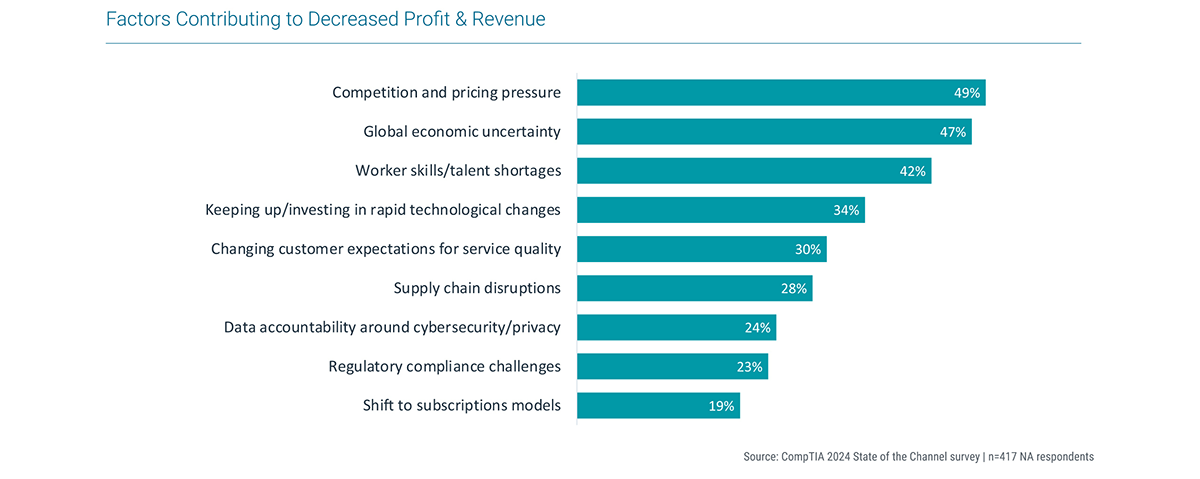
Amid this talk about business lines, revenue and profit projections, it’s a good spot to talk about the elephant in the room: AI and what it means for the channel. After a year of tremendous hype set in motion by the widespread introduction of ChatGPT, the hullabaloo faded slightly toward the end of 2023 as is typical of the trajectory for exciting new technologies. That said, the opportunity around AI is more than hyperbole. It’s very real and the channel is rolling up its sleeves to figure out the best way to engage.
Initially, like many end users they serve, the channel has been spending more time researching, experimenting and piloting AI solutions and projects than selling. In fact, in the CompTIA IT Industry Outlook 2024, respondents reported more internal use of AI solutions to streamline business operations and bolster effectiveness across functional areas such as marketing than they did selling going to market to customers (See accompanying sidebar for a list of some of the ways AI can potentially help a channel firm improve operations).
Experimentation is still going on, but selling AI is now firmly planted on the to-do list for many channel firms. In fact, 47% said they plan to sell AI products and solutions to customers this year. Given the nature of AI, these solutions will likely take the form of products that feature AI as an enabling technology, or, in the case of MSPs, a service line that includes AI functionality. Not surprisingly, the smallest channel firms (those with fewer than 10 employees) are most cautious about diving into AI sales, with just 29% projecting to do so next year. That compares with 46% of small firms, 52% of medium-sized firms and 67% of large firms.


Business Literacy & Fundamentals
Join a conversation or message board chat with people working in the IT channel and you will encounter lots of tech talk. But that’s not all you’ll hear. For many channel pros, a consistent topic has been how to run a business: How to start one, how to staff one, what to sell, how to grow revenue and maximize profits, how to charge for services vs. products, etc. For some, it’s as basic as understanding how to read a balance sheet and access credit or as complicated as navigating tax and legal matters. Cracking the code for effective marketing flummoxes many, as does calculating that ideal multiple to seek when selling the business.
Comparing tactical business notes with peers isn’t surprising. Most channel firms are small in nature, typically fewer than 20 employees, and their primary skill set is technical (see accompanying graphic about channel sizing). And while some enter this market with an existing business background or entrepreneurial experience, for many the requisite skills to run a company are often cultivated on the job. Part of the data collected for this year’s channel research is an attempt to assess how channel firms rate themselves at business fundamentals and what some of the areas of need may be.
Just more than half of respondents (54%) rate their level of overall business acumen as “intermediate.” This covers a range of general business skills and activities including budgeting, forecasting, accounting, tax planning, financial analysis, ROI analysis, risk assessment, among others. That assessment is mostly consistent across firm sizes except for the largest channel firms (500+ employees) that are far more likely to rate their skills in the “expert” category. That demarcation is unsurprising given that these largest channel entities are comprised of the big-name system integrators and IT services firms that mainly serve enterprise customers and are in some cases publicly traded companies themselves.
In total, roughly 4 in 10 firms rate themselves “expert” at business-related skills, while just 6% put themselves in the ranks of “beginner.” Beginner status is more common for micro-sized companies of fewer than 10 employees, with 20% selecting that designation to describe their current level of skill. Groups in both the intermediate and beginner buckets said they have improvements to make across a range of different tactical and strategic elements of running a business, with beginners obviously citing the most work ahead of them. Experts say their business acumen is where they would like it to be today, but of course such measurements across skills are fluid and variable.
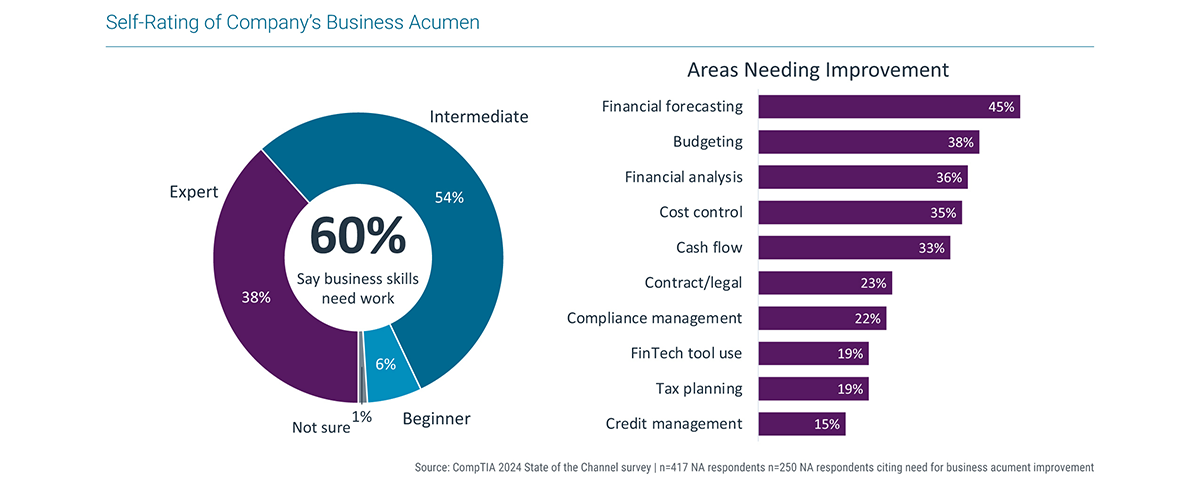
In recent years, mastering the brass tacks of running a channel business has taken on greater urgency. There are a few good reasons for that. One, many channel owners today are actively planning exit strategies, either for an imminent sale or, more often, in the foreseeable but still-years-off future. Savvy owners realize that their ideal sales outcome will be predicated on steps taken in the present day to bolster market value and attractiveness for a later time. That means growing company revenue, building an enterprise that is profitable and operationally efficient, competitively differentiating via new market entrance, tech innovations or specialization. To achieve those things, business acumen is essential. This extends beyond retirement-minded channel firms, but to others involved in the busy M&A activity in the channel of the last couple years that is tied more to growth and expansion strategy than exiting the industry.
The other factor funneling greater attention to these skills is the ongoing upheaval in channel business models and customer buying behavior. More channel firms are embracing consulting by providing more services that purport to drive business outcomes for customers vs. selling them products. This shift necessitates a level of industry and business knowledge perhaps not historically required in the reseller channel. At the same time, more customers are buying their tech products directly from online marketplaces, a major competitor for the channel today. If marketplaces own the initial product transaction, then channel firms need to reinvent their marketing, sales messaging and techniques to reflect their new value to customers: Services, recurring management of technology, consulting and business advice. This requires new attention to sales and marketing expertise that might not map to what a channel firm has done in the past.
“The biggest area of opportunity in my experience working with MSPs is their lack of marketing. It tends to be their Achilles heel and yet their biggest opportunity to differentiate themselves from competitor’s, recruit new customers and grow their business.”
—Michelle Ragusa-McBain, VP of global channels, SonicWall
It’s not surprising that the companies that rate their business acumen most often as “expert” are those firms that report being in better shape than they were two years ago. It’s impossible to know in every individual case whether improvements in business acumen have been the main driver behind better business health and results, but the correlation seems sound to consider generally.
Even among the expert group, there are always areas that need improvement toward attaining better business fluency. No. 1 is financial forecasting, which 45% of respondents cited. Forecasting of any type is difficult, but in the last few years precise prognostication about future sales, profitability, customer demand, etc. has been further complicated by the pandemic’s impact on the economy. Familiar cadences and patterns for such things as average sales cycles, recurring monthly revenue, contract renewals, pricing of supplier goods, went out the window for many channel firms during this period. This coming year could signal a return to more predictability, but getting back to a more comfortable status is a top goal.
Other areas needing improvement are more balanced in terms of ranking: Budgeting (38% of respondents), financial analysis (36%), cost control, operational efficiency (35%), and cash flow management (33%) comprise the middle of the list, each representing a related aspect of better money stewardship. At the bottom of the list of improvements needed are functions that can, theoretically, be outsourced to experts such as compliance and regulatory issue management (22%) and tax planning (19%).
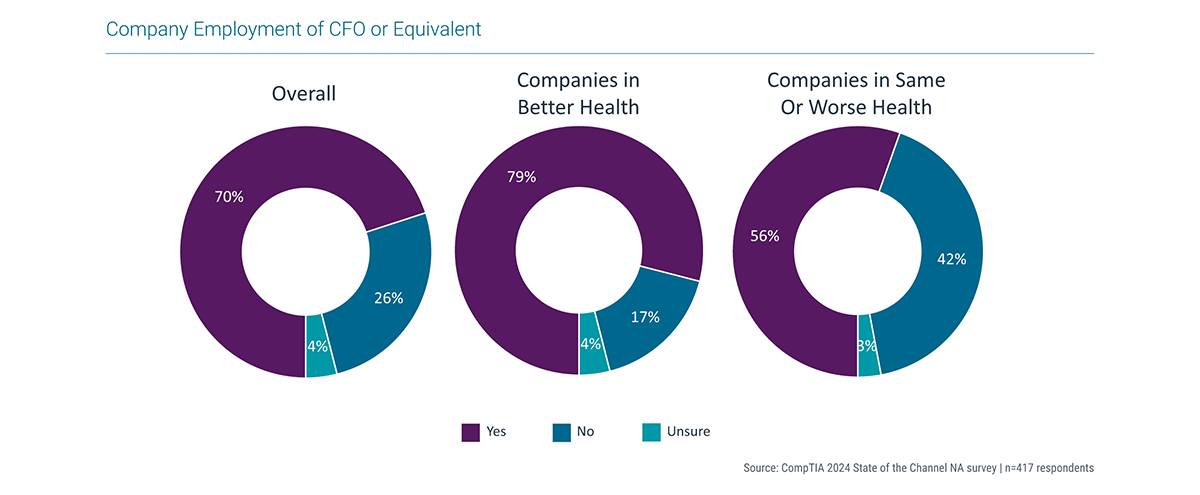
Channel firms looking to shore up or polish existing business operations have a variety of options at their disposal. For 46% of respondents, the main place they’ve turned for help has been industry association/s that offer business-related training and/or certifications. Among medium- and large-sized channel firms, the number availing themselves of industry associations climbs to 55% and 53%, respectively.
Other sources of training, consulting or advice include partner-to-partner networks (39%), vendor-based business training (37%) and third-party business consultants (32%). Looking to third parties for business fluency help, particularly vendors, has been on the wish list for the channel for years now. Consider CompTIA research, Partner Experience Trends, from 2022, in which 40% and 35% of channel firms, respectively, cited operational business training and professional marketing training as benefits they would like their vendor partners to prioritize.

In terms of the training types sought from industry associations, vendors, universities or the like, channel firms most often focus on sales and marketing skills, but also request assistance with business basics pertaining to financial fluency, accounting and human resources policies.
“Partners’ business capabilities often are a function of size – both revenue and staffing. The more resourced partners can address day-to-day business processes with people (i.e., staff or contractors) and increasingly with software and automation tools.”
—Khali Henderson, senior partner, Buzz Theory Strategies
Improving the ways a business operates goes hand in hand with another facet of running a company: The willingness to take risks. In this case, risks related to financing and using credit or other sources of capital to invest in the company’s growth or stability.
Historically, the mostly small-on-the-small-end of SMB companies in the channel have tilted toward the conservative side when it comes to borrowing on credit or taking financial risks in general, whether that’s to enter a new market, fund a cap-ex purchase or finance any other major investment. For companies that are content to stay in their lane with minimal growth aspirations, risk aversion isn’t necessarily a negative. But in today’s more dynamic environment where there’s no longer one or two channel business models in play and the complexity of technology/business solutions is only increasing more quickly, competition to stand out is steep. That often compels making some bets on new investments and directions.
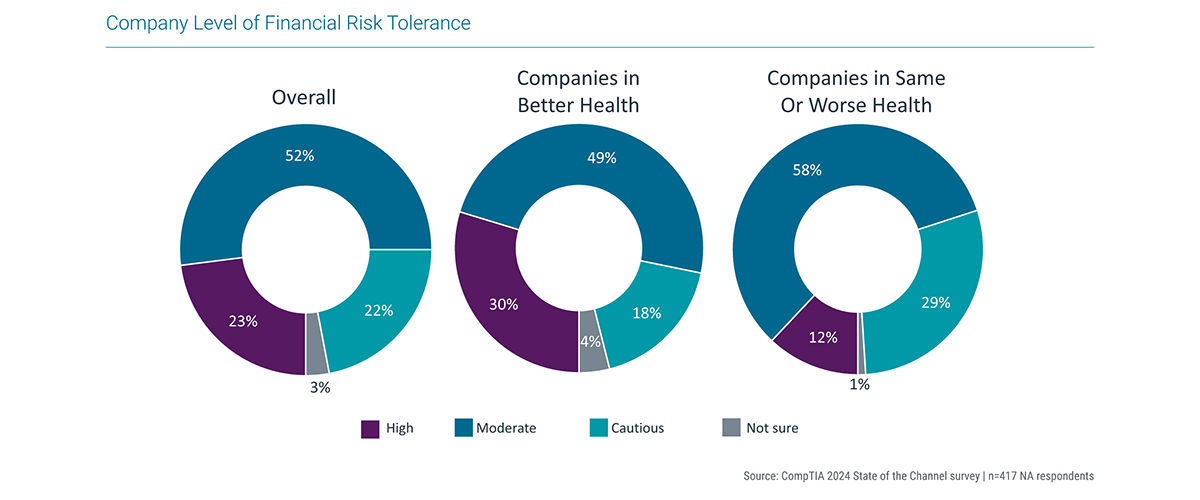
When it comes to using credit, borrowing from third parties, investing in new technologies or markets, etc., 52% of channel firms said they have “moderate” risk tolerance. Just 23% report their tolerance as “high,” which includes 30% and 38% of medium- and large channel firms, respectively, vs. just 6% of micro-sized companies.

The data on company-size-to-risk-tolerance-level ratio is relatively predictable. Smaller firms that often have less room for error in terms of leveraging credit, tapping existing cash flow or making other funding maneuvers report less risk tolerance than their larger peers. Likewise, while 22% of total respondents described their company’s risk tolerance as “cautious,” half of micro-sized companies did so compared with just 8% of the largest firms.
In an indicator that more willingness to borrow or dive into a new market or technology can pay off, companies that said they are in better shape today than they were two years ago reported a higher degree of risk tolerance. Three in 10 of that group said their risk tolerance is high vs. 12% of firms whose business condition is either stable or worse than two years ago. Similarly, that first group was less likely to dub themselves cautious (18%) with respect to risk compared with 29% of the latter group.

When it comes to how the channel funds its investments, one source stands out as relatively unchanged over the long history of the channel: Owners. Four in 10 respondents said that the company owner/s inject their own cash or use personal credit cards to pay for a capital or operational expenditure or to meet another financial obligation. This behavior is common among small companies but reflects an attitude about risk that remains conservative: Owe yourself vs. a third party. Yet many financial advisors will warn against charging major business expenses on a personal credit card as it can result in the loss of legal protections, make it difficult to separate business and personal expenses, complicate tax matters, and thwart the chance to earn additional rewards and benefits.
Vendor Relations & Competitors
No State of the Channel report would be complete without a pulse check on the status of relationships. Specifically, how channel firms are getting along with vendors – or not – and what factors are driving satisfaction or dissatisfaction. Likewise, and especially pertinent in today’s fast-changing ecosystem, is an understanding of the landscape of channel competitors.
One thing is clear: Channel firms have grown far more selective about vendor relationships in recent years, and over this past year specifically have reduced the number of vendors they partner with. Since CompTIA began tracking partner program participation 11 years ago, the sweet spot for the average number of vendor programs channel firms is involved in formally has been between five and 14. That’s changed. This year’s study finds that of all respondents, the largest portion say they participate in between 1 to 9 vendor programs, with a sharp year-over-year increase in the group enrolled in just 1 to 4 programs (see accompanying chart). Even more notably, firms that report participation in no vendor programs at all increased from 7% to 11% year over year.
In fact, program enrollment numbers have declined in every category above 1 to 4 in the list.

What accounts for the drop off in program numbers? Many factors could be in play. Differing business models and new adjacent roles have allowed channel partners to thrive in new and varied ways in the industry. That has impacted how they interact with vendors. The same programs, resources, incentives, and other engagement/enablement mechanisms aren’t as relevant today, leading channel firms on a search for the best fit. This could mean settling on fewer, more relevant and/or profitable vendors on their line card.
Another major factor is the increased emphasis on selling IT and business services by many channel firms. This business model is far less vendor-dependent than one that leans heavily on product sales, which could account for the need by the former to sign up for fewer partner programs. Consider the following: Just 16% of channel firms that identify as sellers of tech products participate in 1-4 vendor programs (the low end of the scale), while 43% of them are involved in a more robust number of 10 more programs. The inverse is true of services-identifying channel firms. Respectively, 33% and 34% of tech services and business solutions firms participate in 1-4 vendor programs, while just 27% and 22% are involved in 10 or more.
MSPs and their business model offers another possible explanation. These firms rely heavily on a primary PSA/RMM platform as the cornerstone application to run their business. Think of those from vendors like ConnectWise, Kaseya and the like. These platform vendors for the past decade or so have been working to improve their integrations to third-party vendor applications like cybersecurity or CRM software, in theory enabling the MSPs more seamless operations of their multi-vendor services stack and potentially less reliance on individual vendor program elements.
Less just might be more, however. Despite a decline in the number of programs channel firms participate in, those they have chosen make them happy. Half of channel firms report being satisfied with their vendor partners, mirroring results from last year’s study. However, there was a notable increase in the number of respondents that checked the box for the superlative option of “very satisfied.” A third of channel firms said this about their vendors this year, nearly double the 18% that said so in last year’s study.
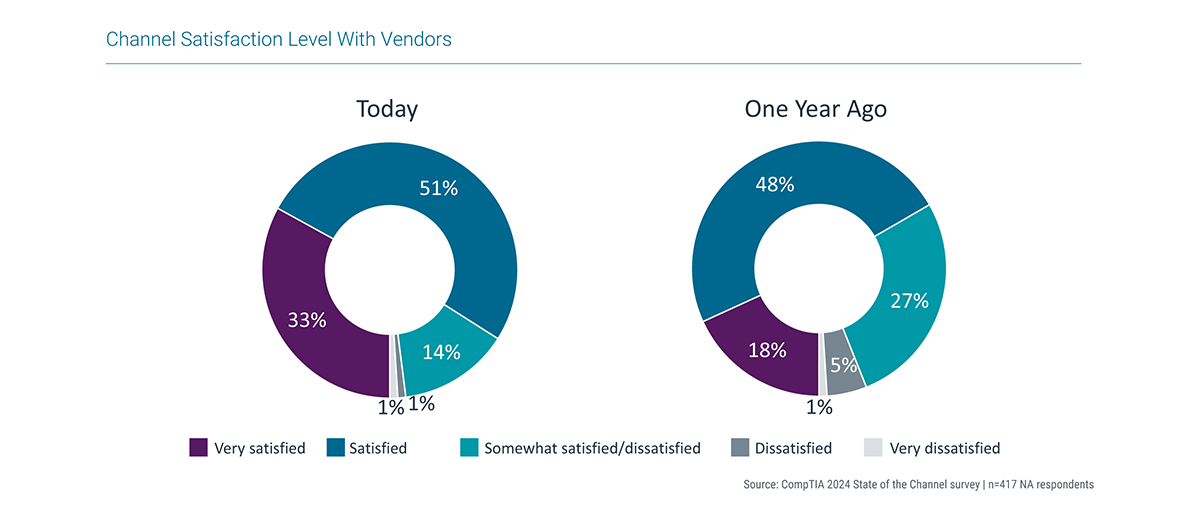
The case can be made that channel firms’ greater selectivity across fewer vendors in total has resulted in better relationships – the old quality vs quantity adage in play. This year’s satisfaction levels map relatively consistently across channel firms of all sizes, with a slight edge in contentment exhibited by the medium to largest companies. These firms typically have reached a more elevated status within vendor partner programs and can exert more leverage in terms of becoming a managed partner with access to more resources such as dedicated channel account managers. But smaller firms, most of the channel, still express a high degree of vendor satisfaction.
Vendor churn is also a phenomenon in the channel. A firm may work with the same number of vendors as the previous year but has changed up the mix of who they are. The No. 1 reason for making a shift is the desire for better profitability and revenue growth – an obvious aspiration that 4 in 10 respondents cited. The second-most cited reason is the desire to enter new markets, not a new activity for channel firms but one accelerating this year with the rush to capitalize on the AI opportunity.
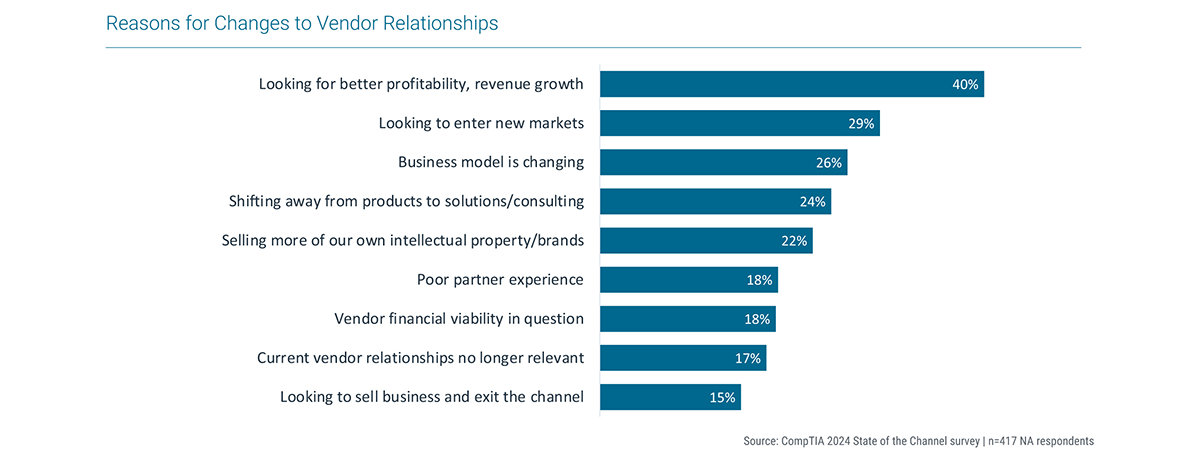
Beyond vendor relationships, the other fast-moving dynamic in the channel’s orbit is its competition. If some things remain the same over a decade in the channel, the competitive picture is not one of them. Today’s primary competition for the average solution provider, reseller or MSP is a rival channel firm, followed closely by online marketplaces and vendors selling direct. This represents a shift in both rank order and incidence from last year when nearly half of respondents (49% and 46%, respectively) cited online marketplace and vendors as their main competition, far ahead of rival channel firms by more than 10 percentage points. Today, the incidence of those three entities being cited as the main competitor to a channel firm has evened out, with 40% of respondents citing rival channel firms, 36% online marketplaces and 35% vendors selling direct.
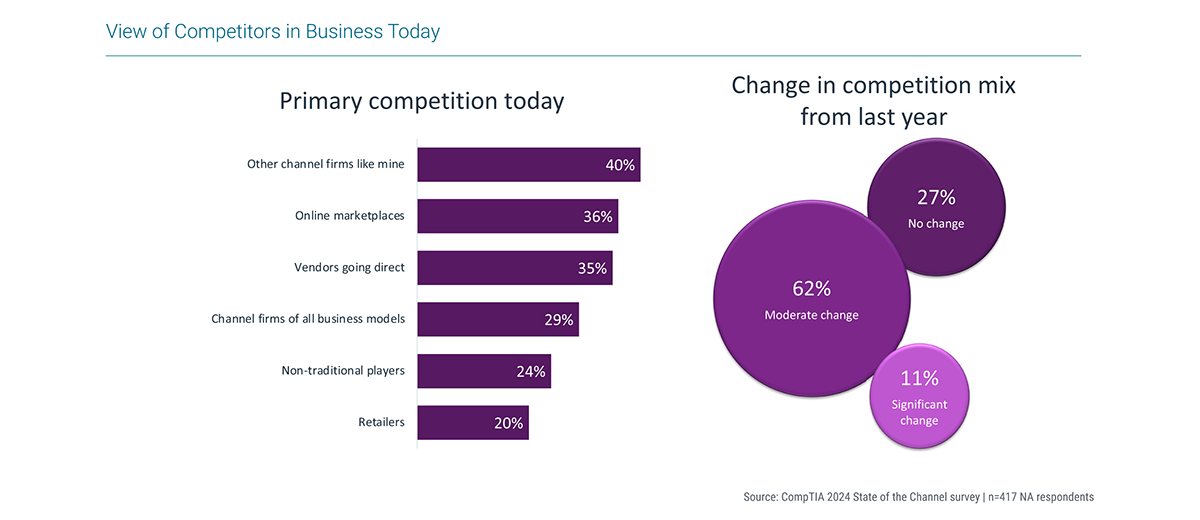
The even balance of competitor types could reflect the channel’s pivot in how they deal with encroachment by online marketplaces – and that is, not to compete head-to-head. The fact is that online marketplaces need not be the channel’s mortal enemy – they are here to stay. Savvy firms have figured out how to work with and around them, selling their own offerings through them with transactions either facilitated by the marketplace e-commerce engine or linked back directly to a channel firm’s own storefront. Additionally, as channel firms increasingly focus on services, one of the major areas of opportunity lies in helping customers navigate marketplaces. Whether the customer then conducts the transaction directly isn’t the point; the channel firm will have engaged pre-sales with consulting help and after the transaction with services for integration, implementation, cybersecurity and the like.
Conclusion
As businesses and the global economy emerge into a post-pandemic environment in 2024, the IT channel remains a dependable mainstay of the technology industry ecosystem – a system of connected, yet diverse companies that serve as technology and business solutions experts. The channel is instrumental to the flow of IT goods and services from vendors and distributors, a conduit for roughly 57% or higher of the total global spend on technology per year.
Times are changing. In the year ahead, the channel will continue its adoption of new technologies like AI, while upping its game in disciplines like cybersecurity where more complex and ubiquitous threats continue to vex the business and consumer markets. Many channel firms are small, and continue to work on their own evolution, whether that is business model transformation such as product-reselling-to-managed-services or seeking outside help to improve business operations and financial fluency.
The nature of vendor relationships is also changing as channel firms shift emphasis to IT and business services sales as their primary business and begin to cull their number of vendor partners to fewer, but more strategic. Some goals for the year include setting their sights on new customer acquisition, improving internal operations and embracing technical complexity as experts that can show customers the way. Many express concerns about pricing and competition from online marketplaces, while worrying about the direction the global economy could go.
There’s much to keep an eye on in 2024 with respect to the IT channel, both up and down. But for any naysayer that’s been predicting the demise of the indirect sales piece of the technology business chain – as some have for years – it isn’t happening.
Methodology
CompTIA’s State of the Channel study provides insights around key channel trends in business environments.
The quantitative study consisted of an online survey fielded to channel professionals during January 2023. A total of 417 respondents in North America participated in the survey, yielding an overall margin of sampling error at 95% confidence of +/- 4.9 percentage points. This survey was also fielded in ANZ, ASEAN, Benelux, DACH, and UK/Ireland. Sampling error is larger for subgroups of the data.
As with any survey, sampling error is only one source of possible error. While non-sampling error cannot be accurately calculated, precautionary steps were taken in all phases of the survey design, collection and processing of the data to minimize its influence.
CompTIA is responsible for all content and analysis. Any questions regarding the study should be directed to CompTIA Research and Market Intelligence staff at [email protected].
CompTIA is a member of the market research industry’s Insights Association and adheres to its internationally respected Code of Standards and Ethics.
